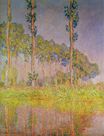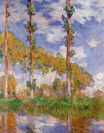Клод Моне - Пшеничные стога. Конец лета 1891
 |
 |
 |
 |
 |
 |
 |

Пшеничные стога. Конец лета 1891
60x100см холст/масло
Art Institute of Chicago, USA
The image is only being used for informational and educational purposes
<< Previous G a l l e r y Next >>
From the Art Institute of Chicago :
The monumental stacks that Claude Monet depicted in his series Stacks of Wheat rose fifteen to twenty feet and stood just outside the artist’s farmhouse at Giverny. Through 1890 and 1891, he worked on this series both in the field, painting simultaneously at several easels, and in the studio, refining pictorial harmonies. In May 1891, Monet hung fifteen of these canvases next to each other in one small room in the Galerie Durand-Ruel in Paris. An unprecedented critical and financial success, the exhibition marked a breakthrough in Monet’s career, as well as in the history of French art. In this view, and in nearly all of the autumn views in the series, the conical tops of the stacks break the horizon and push into the sky. But in most of the winter views, which constitute the core of the series, the stacks seem wrapped by bands of hill and field, as if bedded down for the season. For Monet, the stack was a resonant symbol of sustenance and survival. He followed this group with further series depicting poplars, the facade of Rouen Cathedral, and, later, his own garden at Giverny. The Art Institute has the largest group of Monet’s Stacks of Wheat in the world.